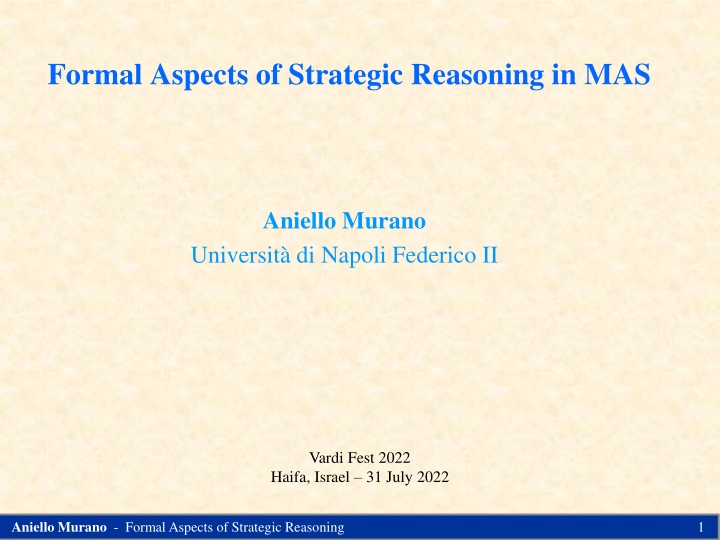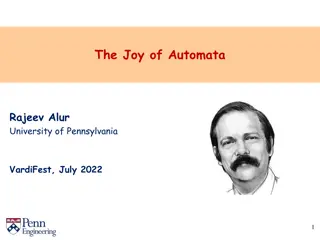
Strategic Reasoning in Multi-Agent Systems - Aniello Murano
Explore the formal aspects of strategic reasoning in multi-agent systems through the works of Aniello Murano, covering topics such as formal verification, module checking, classes of models, and system behavior characterization. The content delves into key concepts like finite-state systems, temporal logics, and model checking, providing insights into the complexity and decodability of open system verification.
Download Presentation

Please find below an Image/Link to download the presentation.
The content on the website is provided AS IS for your information and personal use only. It may not be sold, licensed, or shared on other websites without obtaining consent from the author. If you encounter any issues during the download, it is possible that the publisher has removed the file from their server.
You are allowed to download the files provided on this website for personal or commercial use, subject to the condition that they are used lawfully. All files are the property of their respective owners.
The content on the website is provided AS IS for your information and personal use only. It may not be sold, licensed, or shared on other websites without obtaining consent from the author.
E N D
Presentation Transcript
Formal Aspects of Strategic Reasoning in MAS Aniello Murano Universit di Napoli Federico II Vardi Fest 2022 Haifa, Israel 31 July 2022 Aniello Murano - FormalAspects of Strategic Reasoning 1
In September 2000 Mail to: Prof. Moshe Y. Vardi Subject: Visiting scholar Dear Professor Moshe Y. Vardi, My name is Aniello Murano, I am a PhD student at the University of Salerno, working under the supervision of Prof. Margherita Napoli. My research interests mainly concerns theory of automata, temporal logics and model checking. I would like to spend a period at Rice University as a visiting scholar, working under your supervision [ ] A few hours later: Mail to: Aniello Murano Subject: Re: Visiting scholar I d be happy to host you! Moshe Aniello Murano - Module Checking 2
Formal Verification 1.0 Model Checking Let S be a finite-state system and P its desired behavior S P labelled state-transition graph M a temporal logic formula The system has the required behavior Is the system correct? M satisfies * Courtesy of Orna Aniello Murano - Module Checking 3
Classes of Models [2001] Closed Systems Behavior is fully characterized by system state Open Systems Behavior depends on the interaction with the environment It must be reactive Open System Model: Labelled State-Transition Graph A solution for Open Finite-State Systems: Module Checking [Kupferman, Vardi, Wolper 1996-2001] Aniello Murano - Module Checking 4
Module checking Module M: Kripke structure with a partition into sys and env states An environment behaviour corresponds to a pruning of some env successor states M (reactively) satisfies the spec if all such environment behaviours do it Module checking M r Consider the ATM machine as an open system: 1. Displays a welcome screen 2. Lets the environment choose to view an Ad or withdraw money 3. Performs the requested operation and restarts from 1 Withdraw sys M: Welcome Choose env Open system sys Show Ad sys Aniello Murano - Module Checking 5
LPAR 2005 Jamaica Infinite-state open system verification Pushdown Module checking Main result: Decidable but exponentially harder than Model Checking Moshe, question: What about imperfect information? Main result: Undecidable! With partial observability only on local states: Decidable! Aniello Murano - Module Checking 6
In 2008 You take the red pill... you stay in Wonderland, and I show you how deep the rabbit hole goes Morpheus (The Matrix) It is time to move to Multi-Agent Systems Strategy Logic Moshe (2009): This is an important project. Let us put all our strength into it! Bastien Maubert Giuseppe Perelli Luigi Sauro Fabio Mogavero Sasha Rubin Loredana Sorrentino Rapha l Berthon Vadim Malvone Alessandro Bianco Benjamin Aminof Francesco Belardinelli Marta Kwiatkowska Michael Wooldridge Petr Cermak Alessio Lomuscio Julian Gutierrez Catalin Dima Nathana l Fijalkow Wojciech Jamroga Damian Kurpiewski Patricia Bouyer Orna Kupferman Giuseppe De Giacomo Nicolas Markey Olivier Serre . . . and many others Munyque Mittelmann Laurent Perrussel Martin Zimmerman Daniel Neider Sophia Knight Aniello Murano - Module Checking 7
Strategy Logic (SL) The Model: A Concurrent Game structure. Transitions depend on agents collective actions The Logic (SL): LTL + s. (a, s) there exists a strategy s such that when player a plays strategy s, Insight. Strategies are treated as first order objects and associated to agents by bindings. An example: - ( s1)( s2)( s3)(ai si) Fp a1has a strategy to beat any a2 s strategy with an a3 s counter-strategy Mogavero, M., Perelli, Vardi: Reasoning About Strategies: On the Model-Checking Problem. TOCL 2014 (preliminary results in FSTTCS 2010). ~500 citations Aniello Murano - Module Checking 8
SL: Features, results, and impact Natural and very expressive, much beyond all previous formalisms! Bridges FM, AI, and economic game-theory. Tools on SL have been developed and used in practice Extended in several directions: probabilistic, fuzzy, pushdown, mechanism design, imperfect information (public action/hierarchical visibility). Future directions: More work to make SL suitable in practice. Improving existing tools Work on approximation and learning-integration Aniello Murano - Module Checking 9
When I left Rice Moshe: It is not important how strong your theory is, but rather how strong your supervisor is ! Aniello Murano - Module Checking 10


